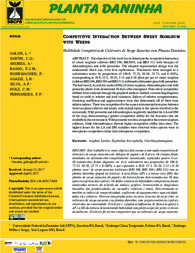Competitive interaction between sweet sorghum with weeds.
Competitive interaction between sweet sorghum with weeds.
Author(s): GALON, L.; SANTIN, C. O.; ANDRES, A.; BASSO, F. J. M.; NONEMACHER, F.; AGAZZI, L. R.; SILVA, A. F. da; HOLZ, C. M.; FERNANDES, F. F.
Summary: The objective of this work was to determine the competitive interaction of sweet sorghum cultivars BRS 506, BRS509, and BRS 511 with biotypes of Alexandergrass and wild poinsettia. The adopted experimental design was the randomized block one, with four replications. Treatments were arranged in a substitution series by proportions of 100:0, 75:25, 50:50, 25:75, and 0:100%, corresponding to 20:0, 15:5, 10:10, 5:15 and 0:20 plant per pot of sweet sorghum (cultivars BRS 506, BRS 509 and BRS 511) withweeds (Alexander grass/wild poinsettia). The leaf area (LA) and dry matter (DM) of sweet sorghum, Alexandergrass and wild poinsettia plants were determined 50 days after emergence. Data about competitive abilities were analysed through the graphical analysis method, constructing diagrams based on yield or relative and total variations. Indices of relative competitiveness, clustering coefficient and aggressiveness were also determined; all of them were relative indices. There was competition for the same environmental resources between sweet sorghum cultivars and weeds, with mutual injury to the species involved in the community. Wild poinsettia and Alexandergrass negatively modified the LA and DM of the crop, demonstrating a greater competitive ability for the resources that are available in the environment. Wild poinsettia was less competitive than sweet sorghum cultivars, while Alexandergrass showed higher competitive ability than them. The highest losses for the LA and DM variables were observed when species were in interspecies competition rather than intraspecies competition.
Publication year: 2018
Types of publication: Journal article
Observation
Some of Embrapa's publications are published as ePub files. To read them, use or download one of the following free software options to your computer or mobile device. Android: Google Play Books; IOS: iBooks; Windows and Linux: Calibre.
Access other publications
Access the Agricultural Research Database (BDPA) to consult Embrapa's full library collection and records.
Visit Embrapa Bookstore to purchase books and other publications sold by Embrapa.

